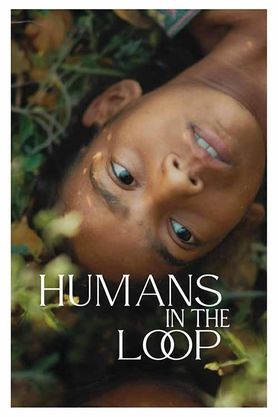Humans In The Loop


A devoted single mother from the Oraon tribe juggles her work in AI technology and her desire to reconnect with her cultural heritage. Meanwhile, her pre-teen son grapples with their new rural life, feeling out of place and longing for the city they left behind. Together, they seek belonging.
September 5
2025
Release Date
Hindi
Language
14 minutes
1 hours
Running Time
Cast


Sonal Madhushankar


Vikas Gupta






Geeta Guha






Gita Guha






Anurag Lugun






Prayrak Mehta






Ridhima Singh
3.5
Average Rating
The above-mentioned average rating is based on the derived ratings of multiple review platforms
OH Review


Film Review: Humans in the Loop
Plot
The movie "Humans in the Loop" brings a unique perspective to the world of artificial intelligence, steering clear of the usual sci-fi tropes. Instead, it anchors itself in a small Jharkhand village, exploring how emerging technologies intertwine with the lives of ordinary people. The narrative centers around Nehma, a young tribal woman who faces personal difficulties yet resolutely finds her way back home to her community. Upon returning, she takes on a job at a data-labelling center, where the task seems mundane – tagging images and videos to train AI systems. This work, however, is far from trivial for Nehma. Each label she produces holds much more significance than just a matter of classification; it is laden with the values, traditions, and ecological understanding of her community. Each decision she makes is a reflection of a negotiation between the demands of the tech-driven world and the wisdom passed down through generations in her culture. As Nehma grapples with her job, the film juxtaposes her professional experiences with her personal struggles, particularly her battle for custody of her daughter, Dhaanu. The narrative takes a thoughtful approach in presenting the ramifications of AI on human lives rather than building a fear narrative about technology's ultimate takeover. Instead of a faceless corporation or an alienating machine, the film portrays AI as a developing child that needs guidance, emphasizing human involvement in technology. The cinematic journey subtly yet profoundly showcases the intersection of labor, caste, and cultural heritage while raising critical questions regarding knowledge and bias. Every scene is crafted to encourage reflection on who counts as an authority and how community wisdom fits into a rapidly digitizing world. This film exists as a bridge between different worlds – one that is often hidden from the mainstream, it tells a story of resilience, connection, and the complexities of modern life made more absorbable through a heartfelt and human lens. The deliberate pacing allows viewers to immerse deeply into Nehma’s world, understanding the stakes of her work and the emotional backdrop of her life. With thoughtful storytelling, "Humans in the Loop" succeeds not only in highlighting pressing contemporary themes but also in evoking a sense of empathy towards the individuals who navigate this harsh intersection of tradition and technology.
Acting
Sonal Madhushankar, who portrays Nehma, delivers an incredible performance that strikes a perfect balance between simplicity and emotional depth. Her portrayal of Nehma is profound, capturing the struggles and silent victories of a young mother striving to reclaim her identity while navigating the challenges presented by modernity. As viewers, we witness not only her determination in the workplace but also the softer moments of vulnerability when she interacts with her children, Guntu and Dhaanu. Their bond is tenderly portrayed, serving as a grounding force against the backdrop of her tumultuous life. The interactions between the characters feel genuine, allowing for a rich exploration of family dynamics and community ties. The performance of Ridhima Singh as Dhaanu aligns within this emotional framework, symbolizing the innocence of childhood contrasted against Nehma’s heavy responsibilities. The young actors’ portrayals help humanize the film’s thematic elements, allowing the audience to relate in a profound way. Supporting performances from the other workers in the data-labelling center add authenticity to the narrative. Their camaraderie and struggles forge a compelling dynamic, elevating the film's portrayal of a working-class reality in a world often dominated by technology. Additionally, the casting is noteworthy for how it reflects the environment in which the story unfolds. The actors carry an inherent warmth that resonates with the film's exploration of communal life against the harshness of industrialized demands. Though some moments may flirt with melodrama, the film generally shines in its ability to showcase the human condition in a relatable manner. It's not just about machines; it's about the individuals who give them life and purpose, and the actors do a commendable job in realizing this vision. Consequently, Madhushankar’s nuanced performance, coupled with a strong supporting cast, makes for an engaging and emotionally rich cinematic experience that lingers long after the credits roll.
Cinematography
The cinematography in "Humans in the Loop" is both striking and thematically relevant, with a thoughtful juxtaposition between the vibrant landscapes of Jharkhand and the sterile interiors of the data-labelling center. The visual storytelling plays a crucial role in establishing a sense of place, grounding the film within the reality of rural India. The camera work often captures the breathtaking natural beauty of the region, from lush greenery to expansive fields, which serves as a sharp contrast to the monotony of the artificial environment where Nehma works. Each frame is composed with a keen sense of detail, enhancing the narrative's emotional weight and cultural significance. Many scenes are bathed in warm natural light, evoking a feeling of closeness to the characters’ world. The cinematographer has a talent for grounding the viewer in Nehma's reality, emphasizing the profound beauty of her cultural backdrop while simultaneously highlighting the encroaching influence of technology. Shots of Nehma walking through her village or interacting with her children are infused with a sense of nostalgia and tenderness. This lens captures a world that is evolving yet is still tethered to its roots, reinforcing the film's central themes of cultural memory and human connection. Counterbalancing these vibrant village scenes is the often claustrophobic aesthetic of the data-labelling center. The camera captures the characters during their repetitive tasks, illuminating the slight discomfort and emotional fatigue that can arise from mechanized labor. The juxtaposition of these two contrasting worlds reflects the inner conflict faced by Nehma and her coworkers—shaping a dialogue between traditional wisdom and modern demands. The visual storytelling is deeply purposeful, using the lens to invite conversation around the intricacies of these interactions. In addition to the well-composed frames, the editing also allows the audience to absorb key moments that may otherwise pass unnoticed. The juxtaposition of visuals, paired with moments of silence or dialogue, allows viewers to delve into Nehma's psyche, revealing her intricate relationship with both her profession and her community. Overall, the cinematography in "Humans in the Loop" is not merely about capturing visuals but serves as a fundamental tool for storytelling, allowing for a richer understanding of the nuanced themes woven into the film’s narrative fabric.
Direction
Directed by Aranya Sahay, "Humans in the Loop" presents a refreshing approach to storytelling that allows for both subtlety and depth. Sahay's direction establishes a connection between the film’s themes and its characters, creating a narrative fabric that weaves personal struggle with broader societal questions. Instead of opting for high-stakes drama, Sahay’s hand is steady and measured, often opting for a documentary-like style that immerses the viewer in the rhythms of everyday life in a tribal village. Though Sahay occasionally flirts with preachy undertones, especially regarding the emotional stakes surrounding AI and community wisdom, the overall direction remains commendably observant. By opting to focus on the raw emotions and thought processes of Nehma, the director places the audience in a position of empathy rather than judgment. This restraint enhances the film's socio-critical discourse without losing its emotional essence. Sahay’s knack for creating authentic moments out of mundane situations fascinates; one can feel the authenticity in scenes filled with office banter, small victories, and quiet heartaches. Each choice made behind the camera feels intentional, encouraging a reflective atmosphere while still remaining grounded in Nehma’s journey. The pacing, although at times slow, helps the audience sit with the characters rather than rushing through their experiences. This deliberate approach invites contemplation and conversation about the significance of the invisible labor that goes into establishing AI. Furthermore, Sahay’s ability to showcase the landscape of Jharkhand introduces a vital cultural context, reinforcing the careful balance between tradition and modernity that Nehma navigates. The nuance with which she handles the intersections of labor, identity, and technological influence reveals a poignant understanding of contemporary life in India. "Humans in the Loop" represents a divergence from traditional narratives surrounding technology, opting instead for a humanistic portrayal that celebrates the quiet strength of its characters. This is ultimately a testament to Sahay's artistic vision—one that champions authenticity and invites viewers to reflect on their understanding of knowledge, bias, and community. Such direction, coupled with a focus on the intricacies of individual and social experiences, makes the film a compelling exploration of what it means to be human in an increasingly digital world.
Conclusion
In conclusion, "Humans in the Loop" is a distinctive and thoughtful film that unfolds the intricate relationship between technology and human lives through the lens of a tribal woman's journey. With a plot rooted in the realities of rural India, it propels conversations about artificial intelligence, labor, and cultural heritage into the forefront, urging viewers to question the structures that govern our understanding of knowledge. The slow-burning narrative, coupled with nuanced performances, carries an emotional weight that resonates long after viewing. The film successfully shines a light on the often-overlooked labor behind AI systems, illustrating how every interaction with technology is intertwined with human decisions and biases. It’s not just a story about a woman working at a data-labelling center but a love letter to communities and wisdom that challenge standardized systems. The handling of personal struggles, societal expectations, and generational knowledge captures the essence of the human experience amidst a rapidly evolving technological landscape. With subtle direction, powerful performances, and stunning cinematography, "Humans in the Loop" presents a fresh narrative that feels both timely and timeless. It breaks further away from the fears often associated with technology and instead examines how interconnected we truly are with the advancements we create. Ultimately, this film is a call for recognition; it compels us to consider not just the future we are building but the people and wisdom that must not be lost in the process. As it leaves us pondering our relationships with technology and community, "Humans in the Loop" stands as a quiet exploration of humanity’s journey in the age of artificial intelligence.
Share this review
The Great Reviews
Times of India
More like this
Dhurandhar
In Dhurandhar, in "Dhurandhar," a gripping tale unfolds as a group of Indian heroes confronts the underworld's darkest forces. Inspired by real events, the f...
Gustaakh Ishq
In Gustaakh Ishq, nawabuddin wants to learn shayari from Urdu poet Ajiz. While visiting, he falls for Ajiz's daughter. They bond over poetry and tea, but mis...


